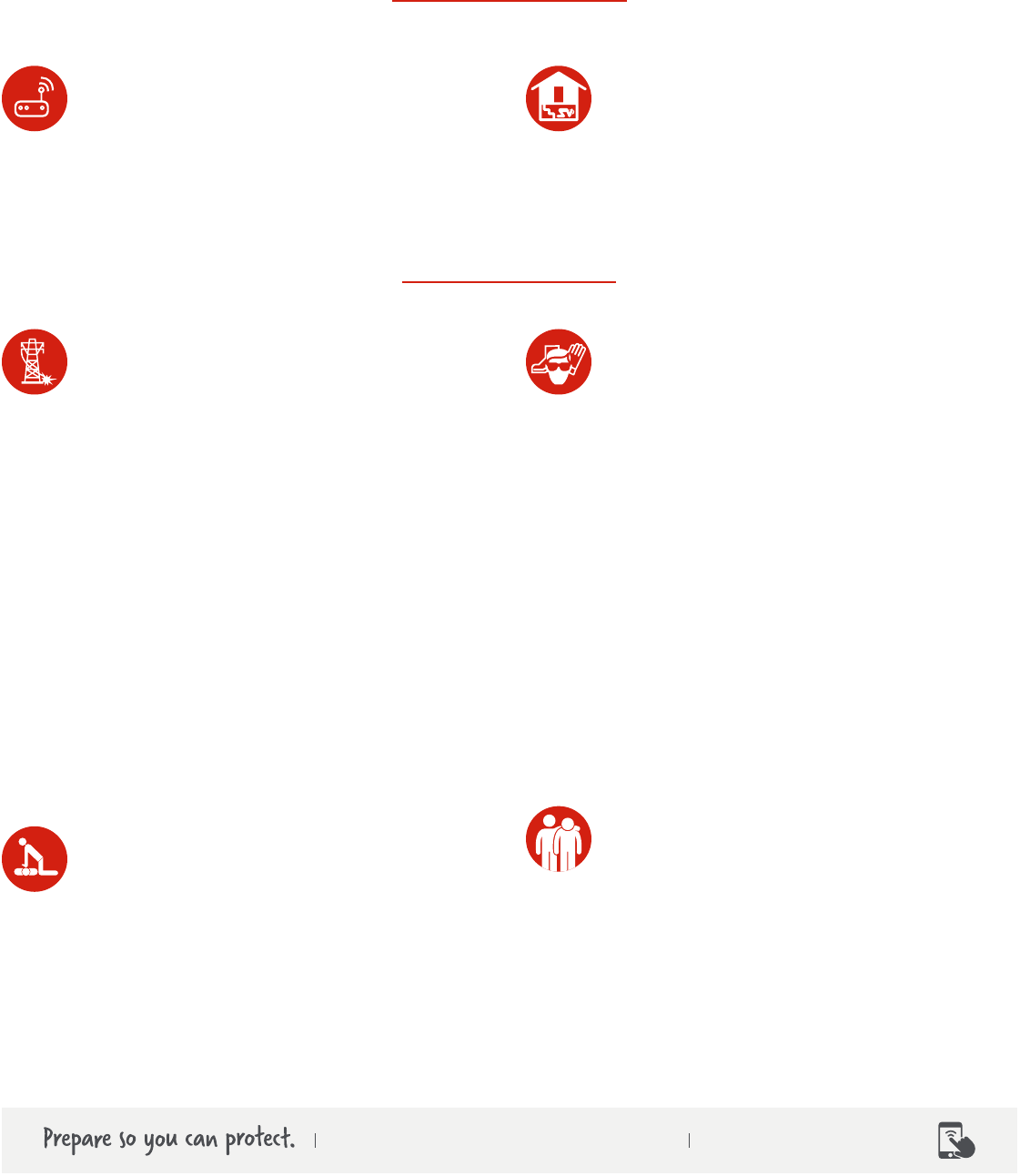
Tornado
Preparedness Checklist
What to Do: Before
A tornado is a tube of spinning air that forms from a thunderstorm and touches
the ground. Tornadoes are dangerous. They can knock down buildings, uproot
trees, move vehicles and destroy things in their path. Heavy rains, lightning,
flash flooding and hail are possible. Tornadoes can happen anywhere. Prepare
now so you can stay safe.
Be Red Cross Ready
Find Shelter Locations from High Winds in
the Places Where you Spend a lot of Time.
• Find a safe room built to withstand high winds.
The next best protection is a small room with no
windows on the lowest level of a sturdy building.
• Mobile, manufactured, trailer homes and
recreational vehicles (RVs) are not safe in high
wind events. Plan ahead by finding a sturdy
building to shelter in before a tornado watch
or warning.
Practice Tornado Drills
• With your entire household, practice moving
quickly to the safe locations that you identified.
• Create a personal support team of people you
may assist and who can assist you.
• If you live in a mobile home, practice going to
a safe place.
Plan to Stay Connected
• Sign up for free emergency alerts from your
local government.
• Plan to monitor local weather and news.
• Have a backup battery or a way to charge your
cell phone.
• Have a battery-powered radio during a
power outage.
• Know the difference between a Tornado Watch
and a Tornado Warning.
-Tornado Watch: Be Prepared! Tornadoes
are possible in and near the watch area.
Be ready to act fast!
-Tornado Warning: Take Action! A tornado is
near. There is danger. Move to safe location
right away.
• You may not always receive a tornado warning.
Know the signs of a tornado. Take shelter if you
feel you are in danger.
Learn Emergency Skills
• Learn First Aid and CPR.
• Be ready to live without power. Utilities may be
offline. Be ready to live without power, gas, and
water. Plan for your electrical needs, including
cell phones and medical equipment. Talk to your
doctor. Plan for backup power.
Gather Emergency Supplies
• Gather food, water and medicine. Stores and
pharmacies might be closed. Organize supplies
into a Go-Kit and a Stay-at-Home Kit.
• Go-Kit: at least three days of supplies that you
can carry with you. Include backup batteries
and chargers for your devices (cell phone,CPAP,
wheelchair, etc.)
• Stay-at-Home Kit: at least two weeks of supplies.
Stores and pharmacies might be closed.
• Have a 1-month supply of medication in a
child-proof container and medical supplies
or equipment.
• Keep personal, financial, and medical records
safe and easy to access (hard copies or
securely backed up). Consider keeping a list of
your medications and dosages on a small card
to carry with you.

What to Do: During
What to Do: After
Tornado Preparedness Checklist
For more information, visit redcross.org/prepare Download the Emergency App
Hazard and Protective Actions Icons are used courtesy of FEMA and are available at community.fema.gov/ProtectiveActions/s/protective-actions-icons
Copyright © 2021 by the American National Red Cross. Version 1. Published January 1, 2022.
Clean Up Safely
• Be careful during clean-up. Wear thick-
soled shoes, long pants and work gloves
to reduce injuries.
• Children should not take part in disaster
cleanup work.
• If power is out, use flashlights or battery-
powered lanterns to reduce fire risk.
• Be aware of carbon monoxide poisoning.
Do not use gasoline, propane, natural gas
or charcoal-burning devices inside a home,
basement, garage, tent or camper — or
even outside near an open window. Carbon
monoxide can’t be seen or smelled, but it
can kill you fast. If you start to feel sick, dizzy
or weak, get to fresh air right away —
do not delay.
Take Care of Yourself
• It’s normal to have a lot of bad feelings, stress
or anxiety.
• Eat healthy food and get enough sleep to help
you deal with stress.
• You can contact the Disaster Distress Helpline
for free if you need to talk to someone. Call or
text 1-800-985-5990.
Seek Safe Shelter Immediately
• If a Tornado Warning is issued. Or, if you
suspect a tornado, seek safe shelter right
away. After getting to your safe shelter, use
your arms to protect your head and neck.
Avoid Injury
• Keep listening to radio, TV or other news
sources. Stay in your shelter until the tornado
warning is over.
• Do not enter damaged buildings.
• If the building you are in has been damaged,
exit with extreme care and stay out. Look
around for things that might fall or dangerous
debris. Do not use matches or lighters inside.
If you smell gas or see spills that could be
flammable, leave immediately.
• If you are trapped, try to cover your mouth
with a cloth or mask to avoid breathing dust.
Try to send a text, bang on a pipe or wall, or
use a whistle instead of shouting.
• Watch out for exposed nails and broken glass.
• Stay clear of fallen power lines or broken
utility lines.
Treat Injuries
• People may be injured. Provide first aid
as needed.
• Do not attempt to move a person with a back
or neck injury unless they are in immediate
danger. Seek immediate medical assistance.
Closely Monitor Weather Conditions
• Tune in to radio, TV or other news sources for
more information about Tornado Watches and
Warnings to be ready to take action.
